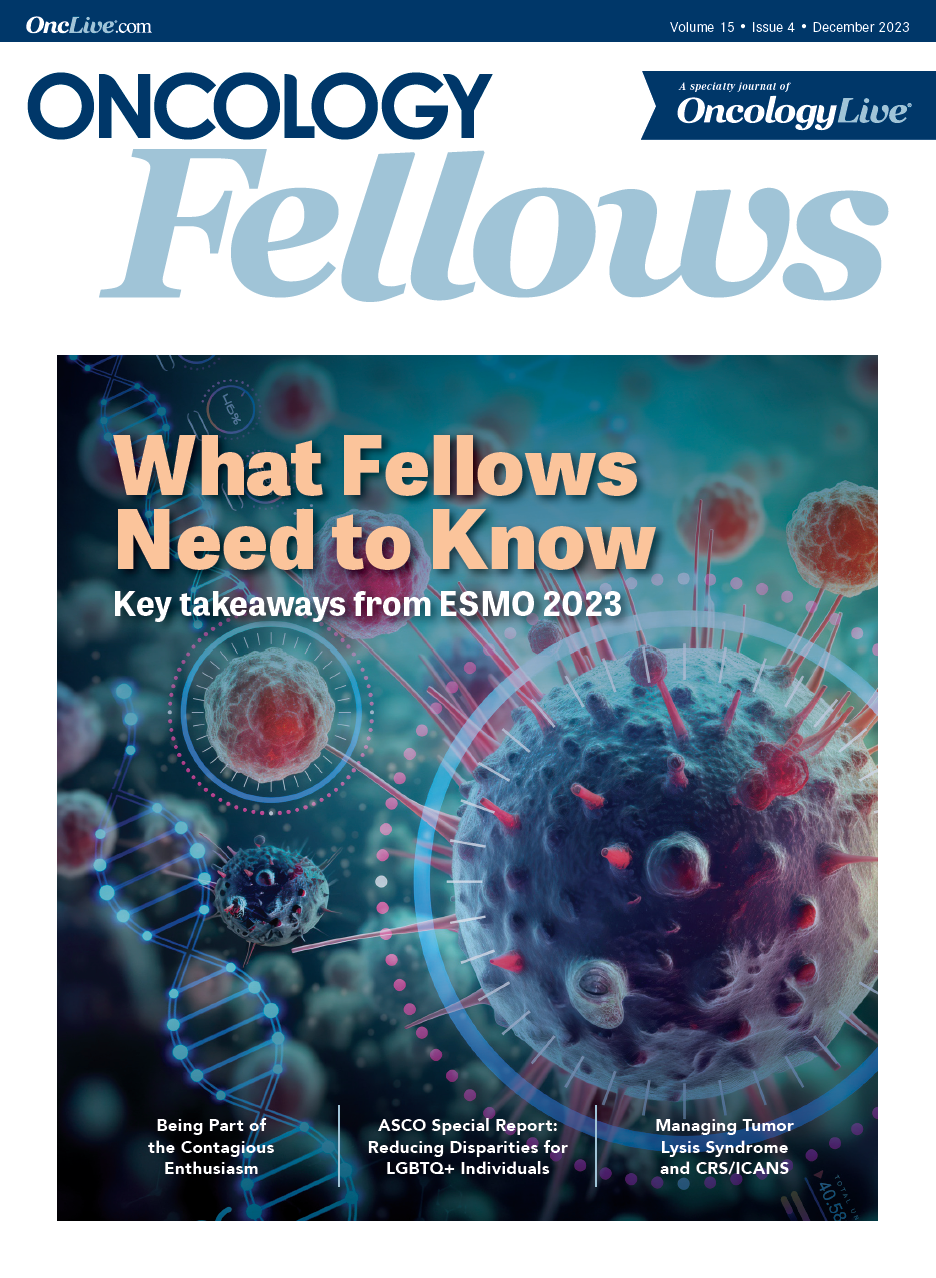News
Article
What Fellows Need to Know: Key Takeaways From ESMO 2023
Author(s):
The 2023 ESMO Congress took place October 20 to 24 in Madrid, Spain, with global perspectives on groundbreaking data. We break down some of the key highlights from the annual meeting that oncology fellows should absorb, and apply to practice, as soon as possible.

The 2023 European Society for Medical Oncology (ESMO) Congress took place October 20 to 24 in Madrid, Spain, with global perspectives on groundbreaking data and practice-altering updates across the gamut of oncology. With hundreds of abstracts presented, we broke down some of the key highlights from the annual meeting that oncology fellows should absorb, and apply to practice, as soon as possible.
Genitourinary Cancers
One of the most notable highlights from the meeting was the presentation of findings from the phase 3 EV-302/KEYNOTE KN-A39 trial (NCT04223856), presented by Thomas B. Powles, MBBS, MRCP, MD. Data from the study demonstrated that the combination of the antibody–drug conjugate (ADC) enfortumab vedotin-ejfv (Padcev) and the PD-1 inhibitor pembrolizumab (Keytruda) led to a significant survival benefit compared with platinum-based chemotherapy in patients with treatment-naive locally advanced or metastatic urothelial cancer regardless of cisplatin eligibility.1
At a median follow-up of 17.2 months, the median overall survival (OS) in the combination arm (n = 442) was 31.5 months (95% CI, 25.4-not reached [NR]) compared with 16.1 months (95% CI, 13.9-18.3) in the chemotherapy arm (n = 444), conferring a 53% reduction in the risk of death (HR, 0.47; 95% CI, 0.38-0.58; P < .00001). Additionally, the median progression-free survival (PFS) was 12.5 months (95% CI, 10.4-16.6) vs 6.3 months (95% CI, 6.2-6.5), respectively (HR, 0.45; 95% CI, 0.38-0.54; P < .00001). The respective objective response rates (ORRs) were 67.7% (95% CI, 63.1%-72.1%) vs 44.4% (95% CI, 39.7%-49.2%).
“The results showed a dramatic increase in PFS. There was a 55% reduction in the risk of progression compared with chemotherapy, which is somewhat unprecedented,” Powles, the director of Barts Cancer Centre at St Bartholomew’s Hospital in London, England, said in an interview with Oncology Fellows. “But more importantly, we also showed an over 50% reduction in the risk of death with a hazard ratio of 0.47, and we’ve not previously managed to beat first-line chemotherapy in any trial in unselected first-line urothelial cancer. This is a big step in that direction.”
Breast Cancer
In breast cancer, findings from the phase 3 TROPION-Breast01 trial (NCT05104866) showed that the TROP2-directed ADC datopotamab deruxtecan (Dato-DXd; DS-1062a) led to a clinically meaningful improvement in terms of PFS compared with chemotherapy for the treatment of patients with hormone receptor–positive, HER2-low or -negative metastatic disease.
The trial met the coprimary end point of PFS; the median PFS in the Dato-Dxd arm (n = 365) was 6.9 months (95% CI, 5.7-7.4) compared with 4.9 months (95% CI, 4.2-5.5) in the chemotherapy arm (n = 367; HR, 0.63; 95% CI, 0.52-0.76; P < .0001). In terms of the other coprimary end point of OS, study authors noted that these data are not yet mature at a median follow-up of 9.7 months. However there was a trend toward the investigational arm vs the control arm (HR, 0.84; 95% CI, 0.62-1.14).2
“We are seeing more and more topoisomerase 1-[directed] ADCs and we don’t have enough data yet to understand how to sequence them, but at the same time having more available agents is always a good thing,” Paolo Tarantino, MD, a researcher at the European Institute of Oncology in Milan, Italy, and clinical research fellow at Dana-Farber Cancer Institute in Boston, Massachusetts, said in an interview with Oncology Fellows. “We know that these patients do require better treatment. These are patients that we mostly treat with chemotherapy and now in just a few years we have [fam-trastuzumab deruxtecan-nxki], sacituzumab govitecan, and now potentially Dato-DXd.”
Lung Cancer
Dato-DXd made waves in another tumor type during the meeting. The agent displayed encouraging efficacy in patients with advanced or metastatic non–small cell lung cancer (NSCLC) in the phase 3 TROPION-LUNG01 study (NCT04656652). Findings showed that patients treated with the ADC (n = 299) experienced a median PFS of 4.4 months (95% CI, 4.2-5.6) compared with 3.7 months among patients who received docetaxel (n = 305; HR, 0.75; 95% CI, 0.62-0.91; P = .004). However, patients with squamous histology did not experience a PFS benefit with Dato-DXd (HR, 1.38; 95% CI, 0.94-2.02).3
“As a coinvestigator in the study, it was really exciting to see [these results] out there,” Jacob Sands, MD, associate oncology medical director of the International Patient Center and a physician at Dana-Farber Cancer Institute, and an assistant professor of medicine at Harvard Medical School in Boston, Massachusetts, said in an interview with Oncology Fellows. “The benefit that we are seeing in nonsquamous NSCLC is impressive; we are seeing a clear separation of the PFS curves. The squamous cell cohort didn’t look the way we had hoped and it raises a lot of questions [about] what to do within this patient population.”
Amivantamab/Lazertinib
Findings from another phase 3 study, the MARIPOSA trial (NCT04487080), showed that the bispecific antibody amivantamab (Rybrevant) plus the EGFR-directed tyrosine kinase inhibitor lazertinib displayed a clinically meaningful improvement in PFS compared with osimertinib (Tagrisso) in patients with treatment-naive, EGFR-mutated NSCLC. At a median follow-up of 22.0 months, the median PFS was 23.7 months (95% CI, 19.1-27.7) vs 16.6 months (95% CI, 14.8- 18.5) in the combination and the osimertinib arms, respectively (HR, 0.70; 95% CI, 0.58-0.85; P < .001). Study authors concluded that their results support the combination of amivantamab and lazertinib as a new standard of care (SOC) for patients with EGFR-mutated advanced NSCLC in the frontline setting.4
Gynecologic Cancers
In another potential standard-of-care update, this time in locally advanced cervical cancer, findings from the phase 3 INTERLACE trial (NCT01566240) showed that the addition of platinum-based chemotherapy prior to chemoradiation conferred PFS and OS benefits vs chemoradiation alone in patients with locally advanced cervical cancer. In the investigational arm (n = 250) the 3- and 5-year PFS rates were 75% and 73%, respectively, compared with 72% and 64% in the chemoradiation alone arm (n = 250; HR, 0.65; 95% CI, 0.46-0.91; P = .013). Additionally, patients who received induction chemotherapy prior to chemoradiation experienced a reduced risk of death of 39% vs those who received chemoradiation alone (HR, 0.61; 95% CI, 0.40-0.91; P = .04).5
“This trial has taken a long time and we are very happy to see that an academic trial can result in an OS benefit,” Ignace Vergote, MD, PhD, chairman of Leuven Cancer Institute and head of the Department of Obstetrics and Gynecology and Gynecologic Oncology at Catholic University of Leuven in Belgium, said in an interview with Oncology Fellows. “We did not really expect it because [data from] all of the earlier trials and metanalyses of neoadjuvant chemotherapy prior to chemoradiotherapy were negative.
But a [previous] subgroup analysis showed that when the induction chemotherapy was given in short courses followed by radiotherapy quickly after…there might be a benefit. That’s exactly what was presented in INTERLACE. The OS difference was substantial, but it’s difficult to interpret because we have [data from] other trials, such as KEYNOTE-A18.”
The phase 3 KEYNOTE-A18 (NCT04221945) trial, which also enrolled patients with locally advanced cervical cancer, evaluated the addition of pembrolizumab to chemoradiotherapy. At a median follow-up of 17.9 months (range, 0.9-31.0), patients who received pembrolizumab plus chemoradiotherapy (n = 529) experienced a 2-year PFS rate of 67.8% compared with 57.3% in the placebo/chemoradiotherapy arm (n = 531; HR, 0.70; 95% CI, 0.55-0.89; P = .0020). Although OS data were only 42.9% mature, a favorable trend toward the pembrolizumab arm was observed (HR, 0.73; 95% CI, 0.49-1.07).6
Study authors concluded that their findings suggest that pembrolizumab to chemoradiotherapy could be considered as a new SOC for patients with newly diagnosed, previously untreated, high-risk locally advanced cervical cancer.
Gastrointestinal Cancers
The ESMO Congress held a notable update in colorectal cancer (CRC). The phase 3 CodeBreak300 trial (NCT05198934), which evaluated sotorasib (Lumakras) plus panitumumab (Vectibix) compared with SOC in patients with chemorefractory KRAS G12C–mutated metastatic CRC, met its primary end point of PFS. The study randomly assigned patients 1:1:1 to receive sotorasib 960 mg daily plus panitumumab (n = 53), sotorasib 240 mg daily plus panitumumab (n = 53), or investigator’s choice of trifluridine/tipiracil (TAS-102; Lonsurf) or regorafenib (Stivarga; n = 54). CodeBreak300 was the first phase 3 trial to examine a KRAS G12C inhibitor in combination with an anti-EGFR antibody in chemorefractory metastatic CRC.7
Additionally, both dose levels of sotorasib plus panitumumab were superior to investigator’s choice of TAS-102 or regorafenib in terms of PFS; patients in the 960-mg and 240-mg groups experienced a median PFS of 5.6 months (95% CI, 4.21-6.31) and 3.9 months (95% CI, 3.71-5.75), respectively, compared with 2.2 months (95% CI, 1.94-3.91) in the SOC arm. Treatment with the combination led to a reduction in the risk of progression or death compared with SOC of 51% (HR, 0.49; 95% CI, 0.30-0.80; P = .006) and 42% (HR, 0.58; 95% CI, 0.36- 0.93; P = .03), in the respective investigational arms.
Hematology
Finally, in the hematologic malignancies session, investigators presented findings from the phase 1/2 EVICTION trial (NCT04243499), which examined the novel anti-BTN3A monoclonal antibody ICT01 in patients with hematologic malignancies for whom the available standard of care was not successful. ICT01 employs a novel therapeutic approach in which it activates γ9δ2 T cells, which has been shown, both in vitro and in vivo, to kill acute myeloid leukemia (AML) blasts and lymphoma cell lines.8
Findings from EVICTION showed that among patients with diffuse large B-cell lymphoma (DLBCL; n = 1), follicular lymphoma (n = 1), and AML (n = 24), 1 partial response (PR) was observed in DLBCL and 3 cases of stable disease (SD) were reported in patients with AML. In 10 efficacy-evaluable patients at week 8, the disease control rate was 30%, with 1 PR and 2 instances of SD occurring in DLBCL and AML, respectively.
Enrollment is underway for the phase 2a expansion portion of the study in the United States and Europe. Phase 2a will evaluate the combination of ICT01, azacitidine, and venetoclax (Venclexta) in patients with newly diagnosed AML.










